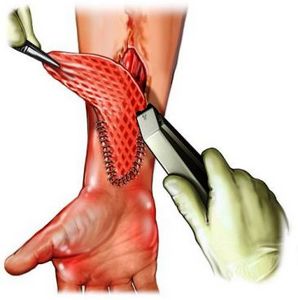Skingraft – Skin graft
Description skin grafting
The operation to transplant skin – removal and transplantation of healthy skin from one part of the body to another. The operation is performed, to replace skin in places, where it has been damaged. Most commonly used for skin grafts grafts with inner thighs, buttocks, The area below the collarbone, front and rear of the ear and the shoulder skin.
Using the patient's own skin as a graft called autograft. If the skin on the body for transplant is missing, skin can be used from other sources. These alternative sources intended for temporary use only, until you grow a patient's own skin. The following sources of skin:
- Allograft skin – the skin of another person;
- Xenograft skin – leather animal origin;
- Synthetic fabrics.
Causes skin grafting
Skin grafts promote healing of injuries:
- Large burns;
- Wounds;
- Sores;
- Bedsores;
- Diabetic ulcers.
Skin grafting is also used to repair skin, removed during operation (eg, after surgery to remove breast cancer).
Successfully transplanted skin adheres to the area transplants. Cosmetic results are dependent on such factors, as the type of skin, the size of the flap graft tissue and health of the patient.
Possible complications of skin grafts
If you plan to transplant skin, you need to know about possible complications, which may include:
- Bleeding;
- Transplant rejection;
- Infection of surgical wounds donor or recipient;
- Poor healing of the skin;
- Changing the transplanted skin;
- The absence of hair growth on the transplanted skin area;
- Tissue transplant prevents movement of limbs.
Factors, that may increase the risk of complications:
- Age: newborns and infants, as well as people 60 and older;
- Smoking;
- Diabetes;
- Poor overall health;
- The use of some drugs.
How is the skin grafts?
Preparation for the procedure
The wound will be cleaned with antiseptic.
Anesthesia
They can be used the following types of anesthesia:
- Local anesthesia – anaesthetises body, during surgery, the patient is awake. It can be provided in the form of injections, often in conjunction with a sedative;
- Regional anesthesia – blocks pain in a particular area of the body, the patient is awake. Administered by injection;
- General anesthesia – blocks any pain and the patient support in a sleep state during operation. Administered intravenously in the arm or hand.
Procedure skin grafting
Early budget measured. Donor tissue, corresponding to the size of the affected area, They will be selected with a scalpel or a special apparatus.
There are three main methods of skin grafting:
- Transplant thin skin flaps – Remove the top layer of skin and part of the middle layer. This type of transplant the most rapidly taking root, but it is also the most vulnerable. Sometimes transplant may also be abnormally pigmented (differences in skin color). This type of graft can be in the form grid, that is, in the transplanted flap performed several holes. Grid allows fluid to drain from the lower layers of tissue.
- Transplant the entire depth of the skin – Although this type of graft requires stitches performance, final result, usually, better, than with the previous method. Transplant the entire depth of the skin, usually, It recommended for areas, where cosmetic appearance is important, eg, for face. This method of skin grafting can only be used on parts of the body, that have significant vascularization (vascularity). In other cases, its use is somewhat limited.
- The composite graft – combination skin and fat, skin and cartilage, or middle layer of skin and fat. It is used in those areas, that require three-dimensional reconstruction, such as the nose.
The graft is applied to the damaged area, then secured sutures or staples.
In the transplanted skin area applied compressive bandage. First 3-5 days may need to install a special device, to drain accumulated fluid. Initially, the graft takes oxygen and nutrients from the underlying tissue. During 36 hours after transplantation begin to grow new blood vessels and cells.

How long will the skin grafts?
Duration of treatment depends on the size of the affected area and the severity of injury.
Skingraft – Will it hurt?
Tackling skin graft can be painful. Anesthesia should prevent pain during the procedure. To remove the pain after the procedure, the doctor provides pain medicine.
The average time of stay in the hospital after skin graft
The time depends on the cause of the operation, the size of the graft, as well as other necessary procedures. For Example, recovery from a burn or accident can take a long time.
Keeping the postoperative period after skin grafting
- Keep the area of selection and grafting skin clean and dry;
- Avoid skin injuries place selection;
- Do not expose the transplanted flap prolonged exposure to sunlight;
- Check operation in the area of healing – after some time, it must acquire a healthy pink color;
- Follow your doctor's instructions for dressing the area transplants. This will speed up the healing process and prevent contractures (limited joint mobility), even after healing.
Contact your doctor after skin grafting
After discharge from the hospital need to see a doctor, If the following symptoms:
- Signs of infection, including fever and chills;
- Redness, edema, strong pain, bleeding or discharge from the surgical wound;
- Headache, muscle aches, dizziness or malaise;
- Cough, breathlessness, chest pain, severe nausea or vomiting;
- Other painful symptoms.
